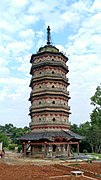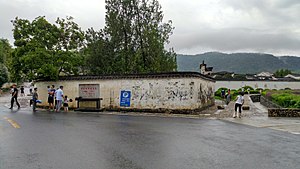Jing County, Anhui
This article needs additional citations for verification. (December 2019) |
Jingxian
泾县 | |
|---|---|
 | |
 Jing County is the westernmost division in this map of Xuancheng | |
 Xuancheng in Anhui | |
| Coordinates: 30°41′19″N 118°25′12″E / 30.6886°N 118.4199°ECoordinates: 30°41′19″N 118°25′12″E / 30.6886°N 118.4199°E | |
| Country | People's Republic of China |
| Province | Anhui |
| Prefecture-level city | Xuancheng |
| Area | |
| • Total | 2,054.5 km2 (793.2 sq mi) |
| Population (2018) | |
| • Total | 307,000 |
| • Density | 150/km2 (390/sq mi) |
| Time zone | UTC+8 (China Standard) |
| Postal code | 242500 |
Jing County or Jingxian (simplified Chinese: 泾县; traditional Chinese: 涇縣; pinyin: Jīng Xiàn) is a county in the south of Anhui Province, People's Republic of China, under the jurisdiction of the prefecture-level city of Xuancheng. It has a population of 360,000 and an area of 2,059 km2 (795 sq mi). The government of Jing County is located in Jingchuan Town.
Jing County has jurisdiction over eleven towns and four townships.
The county is known for its production of Xuan paper and its historic villages.[1]
Administrative divisions[]
Jing County is divided to 7 towns and 2 townships.[2]
- Towns
|
|
- Townships
- Changqiao Township (昌桥乡)
- Tingxi Township (汀溪乡)
Tourism[]
Tourist spots
Preservation of the county's historic villages has been challenging. According to a local official, "The key to preserving villages such as Chaji ... was to convince villagers to stay and not move away to work in the big cities."[3][4] Tourist facilities for visitors to Chaji "have been built on the periphery of the ancient village to retain its pastoral landscape."[5]

Daguan Pagoda


References[]
- ^ "Introduction to the Xuan Paper Making in Anhui China". China Culture Tour.com. 2019. Retrieved 2019-12-17.
- ^ "南京市-行政区划网 www.xzqh.org" (in Chinese). XZQH. Retrieved 2012-05-24.
- ^ "Ancient Chinese villages 'rotting away' for lack of money". South China Morning Post. 2015-01-30. Retrieved 2019-12-16.
- ^ "Chaji Ancient Buildings (Jing County) - 2019". TripAdvisor. 2019. Retrieved 2019-12-16.
- ^ "Traditional Chinese villages in urgent need of preservation". DAWN.COM. 2015-01-31. Retrieved 2019-12-16.
- County-level divisions of Anhui
- Xuancheng
- Anhui geography stubs




